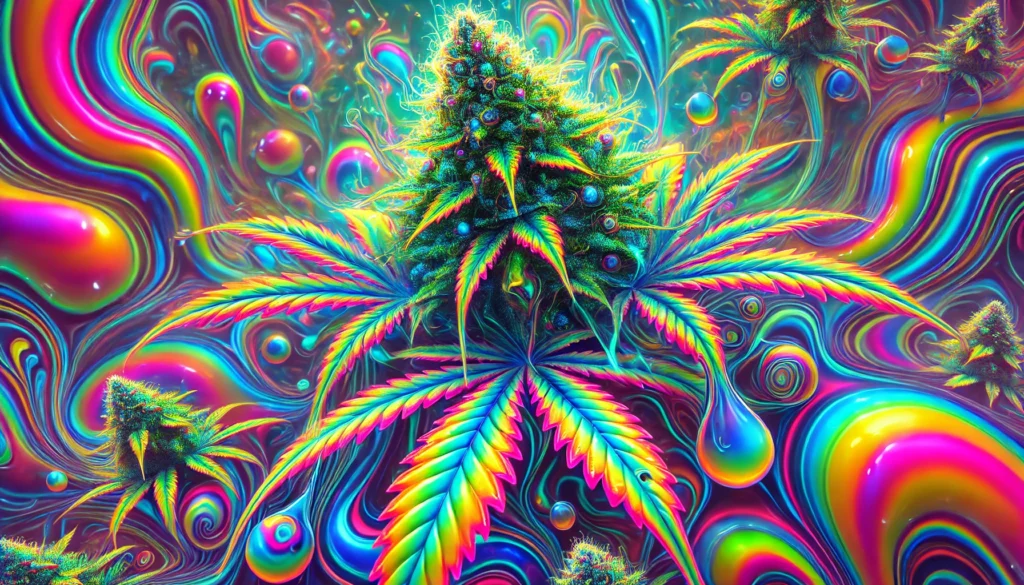Have you ever noticed tiny droplets forming on the tips of your cannabis plants early in the morning? If so, you’ve likely encountered a natural phenomenon known as guttation. But what exactly is cannabis guttation, and why does it happen? Whether you’re a seasoned grower or just starting out, understanding this process can help you take better care of your plants and ensure they thrive.
In this article, we’ll dive deep into the science behind cannabis guttation , explore its causes, benefits, and potential drawbacks, and answer some common questions growers have about this intriguing occurrence. Let’s get started!
What Is Guttation in Cannabis Plants?
To put it simply, guttation is the process by which plants exude water droplets from specialized structures called hydathodes, typically located at the tips or edges of leaves 3. While this might sound alarming at first, guttation is a completely natural process that occurs in many plants, including cannabis. It’s often mistaken for dew, but there are key differences between the two, as we’ll discuss later.
So, why should you care about cannabis guttation? For one, it’s a sign that your plant is actively managing its internal water and nutrient balance. However, excessive guttation could indicate underlying issues like overwatering or poor drainage. Understanding the nuances of this process will empower you to make informed decisions about your plant care routine.
Cannabis Fluids: Guttation vs Dew vs Resin
Before we go further, let’s clarify the difference between guttation, dew, and resin—three fluids you might encounter on your cannabis plants :
- Guttation: These droplets come from the plant itself, pushed out through hydathodes due to root pressure. They often contain a mix of water and dissolved minerals.
- Dew: This forms when moisture in the air condenses on the surface of leaves, usually during cooler nights. Unlike guttation, dew doesn’t originate from within the plant.
- Resin: The sticky substance produced by trichomes on cannabis flowers, resin contains cannabinoids like THC and CBD. It’s entirely unrelated to guttation and serves a different purpose altogether.
Are you now able to distinguish between these fluids? Take a closer look at your plants the next time you notice droplets—what do you think they are?
Physiological Process of Guttation
Understanding the physiological mechanisms behind cannabis guttation can give you greater insight into your plant’s health. Let’s break it down step by step.
When and Why Does Guttation Happen?
Guttation typically occurs when the soil is overly saturated, and transpiration (the process of water vapor leaving the plant) slows down, such as during nighttime or in high-humidity environments 4. When this happens, excess water builds up in the roots, creating pressure that forces liquid out through the hydathodes.
For example, imagine watering your cannabis plants generously before a cool, humid night. The combination of reduced evaporation and increased root absorption can trigger guttation. Have you noticed this pattern in your garden?
A Look at Plant Xylem vs Phloem
The xylem and phloem are two critical vascular tissues in plants responsible for transporting water, nutrients, and sugars. During guttation, water moves upward through the xylem under root pressure, eventually exiting via the hydathodes. Meanwhile, the phloem handles the distribution of sugars produced during photosynthesis.
This distinction highlights how interconnected plant systems work together to maintain balance. Isn’t it fascinating how nature operates with such precision?
How to Identify Guttation in Cannabis Plants
Spotting guttation is relatively straightforward if you know what to look for. Here are some telltale signs:
- Tiny droplets on leaf tips or edges, especially in the morning.
- Droplets that feel slightly sticky or salty to the touch indicate the presence of dissolved minerals.
- A consistent pattern across multiple plants suggests environmental factors rather than disease.
If you see these symptoms, rest assured—it’s likely just guttation doing its thing. But keep reading to learn about the potential consequences of this process.
The Consequences of Guttation in Weed Plants
Like any biological process, guttation has both positive and negative effects on cannabis plants. Let’s explore them in detail.
The Positives of Guttation
On the bright side, guttation helps regulate water and nutrient levels within the plant. By releasing excess water, it prevents issues like root rot caused by prolonged saturation. Additionally, the expelled minerals can sometimes serve as a protective barrier against pests and pathogens.
Have you ever considered how resilient plants are? Even something as seemingly minor as guttation plays a vital role in their survival.
The Negatives of Guttation
However, too much guttation can lead to problems. Excess mineral deposits left behind after the water evaporates may cause leaf burn or discoloration. Moreover, persistent guttation could signal that your growing conditions need adjustment, such as reducing watering frequency or improving drainage.
Do you suspect your cannabis plants are experiencing stress from guttation? Take a moment to evaluate their environment.
Is Cannabis Guttation Sap Psychoactive or Medicinal?
One question many growers ask is whether the sap produced during guttation contains psychoactive compounds like THC or medicinal properties. The short answer is no. Unlike resin rich in cannabinoids, guttation fluid primarily consists of water and trace amounts of dissolved minerals. It lacks the potency needed for therapeutic or recreational use.
That said, the composition of guttation fluid varies depending on the plant’s nutrient intake. Could this variability hold untapped potential for future research? Only time will tell.
Cannabis Guttation: A Natural and Normal Process — Most of the Time
While cannabis guttation is generally harmless, it’s essential to monitor it as part of your overall plant care strategy. Occasional guttation is normal, but frequent occurrences might warrant a closer inspection of your growing practices. Remember, healthy plants are happy plants!
FAQs About Cannabis Guttation
Here are answers to some frequently asked questions about cannabis guttation :
What Causes Cannabis Guttation?
Guttation occurs due to root pressure, which pushes water and dissolved minerals out through hydathodes when transpiration rates are low 5.
Is Guttation Good or Bad?
It’s neither inherently good nor bad. Moderate guttation is normal, but excessive guttation could indicate overwatering or poor drainage.
What Is the Reason Behind Guttation?
The primary reason is an imbalance between water uptake and evaporation, often caused by environmental factors like humidity and temperature.
What Are the Benefits of Guttation?
Benefits include regulating water and nutrient levels and potentially deterring pests.
Does Guttation Mean Overwatering?
Not necessarily, but it can be a sign of overly wet soil. Check your watering schedule and drainage system.
How Do You Stop Guttation?
Improve drainage, reduce watering frequency, and ensure proper airflow around your plants.
Does Root Pressure Cause Guttation?
Yes, root pressure is the driving force behind guttation.
Can Guttation Damage Leaves?
In rare cases, mineral deposits from guttation can cause leaf burn or discoloration.
Conclusion
Understanding cannabis guttation is key to becoming a more knowledgeable and effective grower. From identifying guttation droplets to recognizing its implications for plant health, every piece of knowledge brings you closer to mastering the art of cultivation.
Now that you’ve learned all about cannabis guttation, we’d love to hear from you! Have you observed this process in your plants? What steps have you taken to address it? Please share your experiences in the comments below or join our community forum to connect with fellow growers.
And don’t forget to subscribe to our newsletter for more expert tips and insights on growing top-notch cannabis. Together, let’s cultivate success—one droplet at a time!

